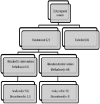Pain relief after cesarean section: Oral methadone vs. intramuscular pethidine
- PMID: 23264787
- PMCID: PMC3525031
Pain relief after cesarean section: Oral methadone vs. intramuscular pethidine
Abstract
Background: Appropriate pain management is needed during the post-partum hospitalization period for preventing cesarean section (CS) related complications. Protocols of post-partum pain management should be planned based on the facilities of each center or region. The aim of current study was to compare the analgesic efficacy of oral methadone and intra muscular (IM) pethidine which the latter was routinely used in our center in post cesarean pain treatment.
Materials and methods: In this prospective double-blind clinical trial, women who were candidate for cesarean section were selected and randomized into two groups. All patients routinely received a single IM pethidine dose (50 mg) after CS in the recovery room. One group of patients received 0.7 mg/kg pethidine every 6 hour IM, and another group received 0.07 mg/kg oral methadone every 6 hour. Severity of pain assessed using visual analogue scale (VAS) score in 6, 12, 18 and 24 hour after surgery.
Results: Pain severity in methadone group at 6, 12, 18 and 24 hour post operation were 6.4 ± 0.9, 3.4 ± 0.8, 1.9 ± 1.1, 0.5 ± 0.5 (p < 0.05) and for patients in pethidine group were 6.6 ± 0.8, 3.4 ± 0.9, 2.1 ± 1.0 and 0.5 ± 0.5 (p < 0.05), respectively (Mean ± SD). Between groups differences in each follow up time were not statistically significant. There was no difference between groups in terms of complications and supplementary analgesic use.
Conclusion: Considering the similar analgesic effects of methadone and pethidine, satisfaction of patients and nursing system with methadone use and the cost benefit of methadone, it can be recommended to use methadone for post operative pain relieving.
Keywords: Cesarean Section; Methadone; Pain; Pethidine.
Conflict of interest statement
Similar articles
-
The effects of indomethacin, diclofenac, and acetaminophen suppository on pain and opioids consumption after cesarean section.Perspect Clin Res. 2013 Apr;4(2):136-41. doi: 10.4103/2229-3485.111798. Perspect Clin Res. 2013. PMID: 23833739 Free PMC article.
-
A double blinded randomised placebo-controlled study of intramuscular pethidine for pain relief in the first stage of labour.BJOG. 2004 Jul;111(7):648-55. doi: 10.1111/j.1471-0528.2004.00160.x. BJOG. 2004. PMID: 15198753 Clinical Trial.
-
Efficacy and safety of repeated postoperative administration of intramuscular diclofenac sodium in the treatment of post-cesarean section pain: a double-blind study.Arch Med Res. 2001 Mar-Apr;32(2):148-54. doi: 10.1016/s0188-4409(01)00254-5. Arch Med Res. 2001. PMID: 11343813 Clinical Trial.
-
Evaluation of the analgesic effect of subcutaneous methadone after cesarean section.Adv Biomed Res. 2014 Sep 23;3:197. doi: 10.4103/2277-9175.140679. eCollection 2014. Adv Biomed Res. 2014. PMID: 25337527 Free PMC article.
-
The comparison of intraincisional injection tramadol, pethidine and bupivacaine on postcesarean section pain relief under spinal anesthesia.Adv Biomed Res. 2012;1:53. doi: 10.4103/2277-9175.100165. Epub 2012 Aug 28. Adv Biomed Res. 2012. PMID: 23326784 Free PMC article.
Cited by
-
Pentazocine Alone Versus Pentazocine Plus Diclofenac for Pain Relief in the First 24 Hours after Caesarean Section: A Randomized Controlled Study.J Clin Diagn Res. 2017 Apr;11(4):QC01-QC05. doi: 10.7860/JCDR/2017/25294.9519. Epub 2017 Apr 1. J Clin Diagn Res. 2017. PMID: 28571211 Free PMC article.
-
Intravenous paracetamol versus intramuscular pethidine in relief of labour pain in primigravid women.Niger Med J. 2014 Jan;55(1):54-7. doi: 10.4103/0300-1652.128167. Niger Med J. 2014. PMID: 24970971 Free PMC article.
-
Comparison of Efficacy of Bupivacaine with Dexmedetomidine Versus Bupivacaine Alone for Transversus Abdominis Plane Block for Post-operative Analgesia in Patients Undergoing Elective Caesarean Section.J Obstet Gynaecol India. 2018 Apr;68(2):98-103. doi: 10.1007/s13224-017-0990-7. Epub 2017 Apr 26. J Obstet Gynaecol India. 2018. PMID: 29662278 Free PMC article.
-
The effect of intravenous Dexamethasone on post-cesarean section pain and vital signs: A double-blind randomized clinical trial.J Res Pharm Pract. 2013 Jul;2(3):99-104. doi: 10.4103/2279-042X.122370. J Res Pharm Pract. 2013. PMID: 24991614 Free PMC article.
-
Randomized comparison of effectiveness of unimodal opioid analgesia with multimodal analgesia in post-cesarean section pain management.J Pain Res. 2013 May 28;6:419-24. doi: 10.2147/JPR.S44819. Print 2013. J Pain Res. 2013. PMID: 23766658 Free PMC article.
References
-
- Snell P, Hicks C. An exploratory study in the UK of the effectiveness of three different pain management regimens for post-caesarean section women. Midwifery. 2006;22(3):249–61. - PubMed
-
- Pan PH. Post cesarean delivery pain management: multimodal approach. Int J Obstet Anesth. 2006;15(3):185–8. - PubMed
-
- Faboya A, Uncles D. Post Caesarean delivery pain management: multimodal approach. Int J Obstet Anesth. 2007;16(2):185–6. - PubMed
-
- Gadsden J, Hart S, Santos AC. Post-cesarean delivery analgesia. Anesth Analg. 2005;101(5 Suppl):S62–S69. - PubMed
-
- Polushin I, Korostelev I, Nevliaev TI, Petrov VE, Shirokov DM. [Patient-controlled postoperative analgesia in obstetrics and gynaecology] Anesteziol Reanimatol. 2010;(6):41–6. - PubMed
LinkOut - more resources
Full Text Sources

